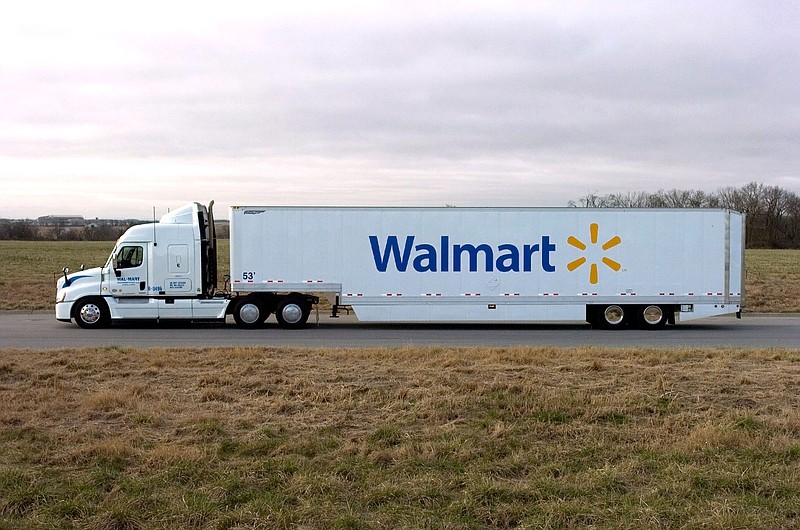Walmart executives told investors on Wednesday that plans to increase profitability over the next few years include increasing automation in its stores and warehouses and creating a state-of-the-art supply chain network.
Speaking on the second day of Walmart Inc.'s annual investors' meeting, held this year in Tampa, Fla., Chief Executive Doug McMillon said he expected that by February 2026, about 65% of Walmart stores will be largely automated. About 55% of the retailer's fulfillment center warehouses will also be automated, he said.
Those measures could improve the company's unit cost averages by about 20%, McMillon said.
McMillon also touted a "next-generation" supply chain that will use data, software and robotics to increase speed, accuracy and productivity as merchandise is moved to fulfillment centers and stores.
The supply chain already includes stores that are being used both as places to shop and as delivery and fulfillment centers. The new technologies will help create an integrated supply chain network to improve inventory accuracy and flow to customers and store shelves.
Walmart pointed to a blueprint for the future at a sprawling distribution center in Brooksville, Fla., about 40 miles northeast of Tampa. Inside, where only employees once manually unloaded cases of goods from truck trailers, autonomous forklifts now do much of the work while people step in to handle problems the machines can't solve.
"Now I'm watching the robot unload the truck," said Jose Molina, a veteran employee. He and colleague Allen Hala, who spoke with reporters accompanied by Walmart executives, recalled the old system of physically demanding labor and cumbersome paperwork to track merchandise.
"We used to be exhausted leaving here," Hala said. "I actually go home and do a lot more now."
One of Walmart's 42 ambient-temperature regional distribution centers, the Brooksville building covers 1.4 million square feet, or the equivalent of about 24 football fields.
Large robots sort cases and send them into a vast network of shelves. A dense storage system enables Walmart to keep more goods in the same floor area before they're sent out to stores. And scanners record which items are where in an effort to improve inventory accuracy and respond to consumer demand more quickly.
Recent regulatory filings show that Walmart's job cuts at five U.S. e-commerce fulfillment centers will affect more than 2,000 positions, though affected employees may find other roles at the company.
The losses include more than 1,000 positions at a warehouse in Fort Worth, the Texas workforce commission said Monday. Walmart is also anticipating a reduction of almost 600 jobs at a Pennsylvania fulfillment center, 400 in Florida and about 200 in New Jersey. An additional reduction is planned in California.
Walmart is also growing in some areas as it adjusts its stores and fulfillment centers to handle more online orders, a spokesman said in an email.
The company has managed to avoid the kind of mass layoffs underway at rival Amazon.com, which said last month it would eliminate a further 9,000 jobs in addition to 18,000 recent cuts.
With so much of the company's operations becoming automated, McMillon said he expects hiring to remain relatively flat. That will allow Walmart to invest more in employees through increased wages and benefits, career training and educational opportunities, he said.
"We believe our combination of wages and benefits have us well positioned to achieve our growth and profitability objectives," McMillon said. "We'll adjust as the market changes, but our current position, including our investment in education, have us in the right range."
With the success of its push to become an omnichannel retailer, McMillon said, the company expects to grow at about 4% a year "regardless of headwinds and tailwinds."
That growth will be driven by the retailer's strength in its retail stores and its expanding digital relationship with customers, he said.
John David Rainey, Walmart's chief financial officer, said that achieving the targeted 4% sales growth over the next five years would add more than $130 billion of sales on top of its current roughly $600 billion base.
"Looking at where we are today," Rainey said, "we believe that approximately 4% sales growth, and growing operating income at a faster rate, are still the appropriate targets for our business over the next three to five years."
"The investments we've made have positioned us well and stand to generate steady and sustained growth at higher margins," he said.
Those investments include its advertising, data, memberships and marketplace businesses -- "all initiatives that will help deliver a better customer and member experience while driving stronger returns," Rainey said.
The company also reiterated its guidance for the first quarter of fiscal 2024 and for the full year for investors.
For the quarter, which ends April 30, Walmart expects adjusted earnings per share of $1.25 to $1.30, with consolidated net sales up 4.5% to 5% in constant currency. Constant currency refers to a fixed exchange rate that allows companies to eliminate fluctuations when calculating financial results.
Consolidated operating income is expected to grow 3.5% to 4% in constant currency.
For fiscal 2024, which ends Jan. 31, Walmart expects net sales to rise 2.5% to 3% and consolidated operating expenses to increase slightly.
Of the company's three divisions, Walmart International is expected to beat out the others with net sales rising about 6%. Sam's Club U.S. same-store sales, or sales at stores open at least a year, are expected to climb about 5% excluding fuel.
And Walmart U.S. expects same-store sales to grow about 2% to 2.5% excluding fuel.
Same-store sales are considered a key indicator of a retailer's health.
Walmart shares rose $2.44, or 1.7%, to close Wednesday at $149.67. The shares have traded between $160.77 and $117.27 in the past 52 weeks.
Information for this article was contributed by Serenah McKay of the Arkansas Democrat-Gazette and Brendan Case of Bloomberg News.

